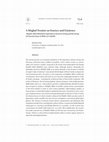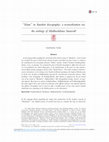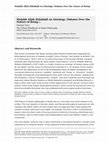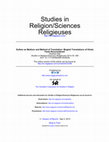Books by Shankar Nair
Papers by Shankar Nair

Journal of Sufi Studies, 2021
This article presents an annotated translation of "The Equivalence between Giving and Receiving" ... more This article presents an annotated translation of "The Equivalence between Giving and Receiving" (al-Taswiya bayna al-ifāda wa-l-qabūl), a short Arabic treatise on essence (dhāt) and existence (wujūd) composed by the South Asian philosopher-Sufi, Shaykh Muḥibb Allāh Ilāhābādī (996–1058/1587–1648). Although modern scholarship has habitually referred to Muḥibb Allāh as an ardent defender of the doctrine of waḥdat al-wujūd (“unity of existence”) associated with the figure of Ibn al-ʿArabī, such generalized formulations fail to do justice to the uniqueness of Muḥibb Allāh’s intellectual contributions. Most authors who had set out to provide a philosophical defense of Ibn al-ʿArabī’s teachings – including the well-known likes of Ṣadr al-Dīn al-Qūnawī, ʿAfīf al-Dīn al-Tilimsānī, ʿAbd al-Razzāq Kāshānī, Dāwud al-Qayṣarī, ʿAbd al-Raḥmān Jāmī, Mullā Ṣadrā, and so on – had tended to prioritize a philosophically utilizable formulation of wujūd or “existence.” Muḥibb Allāh, in notable contrast, favors a presentation of the divine Reality in terms of “pure essence/quiddity” (dhāt/māhiyya maḥḍa), at times going to considerable lengths to uphold his alternative formulation. Such a strategy of argumentation is uncommon amongst philosophical defenders of Ibn al-ʿArabī, the distinctiveness of which is further enhanced by Muḥibb Allāh’s peculiar mode of disputation, which straddles the line between metaphysics and natural philosophy/physics. The Taswiya occasioned at least sixteen commentaries and refutations; this translation benefits from consulting the earliest of these, composed by Mullā Maḥmūd al-Jawnpūrī (d. 1062/1652) and Khwāja Khwurd (d. 1073/1663), as well as three later commentaries by Ḥabīb Allāh Paṭnaʾī (d. 1140/1728). Most significantly, this translation makes extensive use of Muḥibb Allāh’s own Persian auto-commentary, the Sharḥ-i taswiya, which is a critical aid for deciphering the author’s at times opaque manner of expression and argumentation.

Journal of the Royal Asiatic Society, 2021
In the ongoing debate regarding the construction of the modern concept of “Hinduism”, recent rese... more In the ongoing debate regarding the construction of the modern concept of “Hinduism”, recent research has considered the ways in which the pre-colonial encounter with Islam may have served as a catalyst in the crystallisation of an increasingly self-aware “Hindu” identity. Andrew Nicholson (Unifying Hinduism, 2010), in particular, has examined the genre of Sanskrit doxography to affirm that such a process of crystallisation was indeed taking place, as the transformations in this genre over time indicate a nascent Hindu identity emerging in the face of the “Muslim threat”. This article reevaluates Nicholson's account with reference to the writings of one Sanskrit intellectual operating at the height of Muslim power in South Asia: the figure of Madhusūdana Sarasvatī (fl. sixteenth-early seventeenth centuries). Madhusūdana's short doxography, the Prasthānabheda, often features in arguments for the pre-colonial roots of the concept of “Hinduism”; Madhusūdana's other doxographical writings, however, are typically neglected. Based upon an analysis of Madhusūdana's Siddhāntabindu and Vedāntakalpalatikā, this article suggests that a more nuanced consideration of the different audiences and authorial intentions that different doxographers had in mind can offer a modified picture of how early modern Sanskrit intellectuals were responding to the Muslim presence in the subcontinent.

The Oxford Handbook of Indian Philosophy, ed. Jonardon Ganeri, 2017
This article reconsiders the debate among Indian Muslim intellectuals regarding the philosophical... more This article reconsiders the debate among Indian Muslim intellectuals regarding the philosophical doctrines of waḥdat al-wujūd (“unity of being”) and waḥdat al-shuhūd (“unity of witnessing”). With a view to reconstructing some of the broader Muslim scholarly networks that characterized the early modern subcontinent, I turn to Muḥibb Allāh ibn Mubāriz Ilāhābādī’s (1587–1648 c.e.) Arabic treatise on ontology, al-Taswiya bayna al-ifāda wa’l-qabūl, and the series of commentaries attached to it. An analysis of this treatise allows for the exploration of one of the foundational topics in Islamic metaphysics: the conceptual distinction between “quiddity” (māhiyya) and “being” or “existence” (wujūd). Through surveying the rival philosophical views given voice in the treatise—hailing from the Peripatetic, Ash‘arī, Illuminationist, “wujūdī,” and other traditions and involving such important Indian Muslim thinkers as Mullā Maḥmūd al-Jawnpūrī and Khwāja Khwurd—I hope to offer some early steps toward a fuller appreciation of the diverse currents of premodern South Asian Islamic philosophical debates, which extend far beyond the mere wujūd-versus-shuhūd dichotomy that has problematically preoccupied modern historians.

Studies in Religion/Sciences Religieuses, 2014
During the height of the Mughal Empire in pre-colonial South Asia (16th–17th century CE), Muslim ... more During the height of the Mughal Empire in pre-colonial South Asia (16th–17th century CE), Muslim nobles facilitated the translation of numerous Hindu Sanskrit texts into the Persian language. While this “translation movement” (Ernst, 2003: 173) had long been attributed to the reputedly liberal, tolerant, and enlightened personal inclinations of the Mughal emperors, scholars in recent decades have begun to re-evaluate the phenomenon, arguing instead that practical socio-political considerations and quotidian cultural processes best explain the nature of the translation movement. What such analyses lack, however, is a sustained consideration of how the Islamic – and, in particular, Sufi – worldview(s) of the nobles in question shaped the inner workings of, and motivations behind, this movement. In this essay, I take up one such translation from the Mughal period – Mir Findiriski’s Muntakhab-i Jug Basisht, a translation of the Sanskrit Laghu-Yoga-Vasistha – examining not only its content in relation to the Sanskrit original, but also the manner in which Sufi thought and metaphysics informed the very process of translation itself.
Durant l’apogée de l’Empire moghol en Asie du Sud précoloniale (XVIe et XVIIe siècles de notre ère), des nobles musulmans ont facilité la traduction de nombreux textes sanscrits hindous en persan. Même si ce « mouvement de traduction » (Ernst, 2003: 173) a été longtemps attribué aux inclinations personnelles réputées libérales, tolérantes et éclairées des empereurs moghols, les chercheurs au cours des dernières décennies ont commencé à réévaluer le phénomène, soutenant plutôt que des considérations pratiques sociopolitiques et des processus culturels quotidiens expliquent bien mieux la nature de ce « mouvement de traduction ». Cependant, ce qui fait défaut à ces analyses, c’est la considération soutenue de la manière dont les vision(s) du monde islamique – soufi tout particulièrement – des nobles ont façonné les rouages à l’intérieur, et les motivations à l’arrière, de ce mouvement. Dans cet essai, je prends une de ces traductions de la période moghole – Muntakhab-i Jug Basisht de Mir Findiriski, une traduction du Laghu-Yoga-Vasistha en sanskrit – pour en examiner non seulement son contenu par rapport à l’original sanskrit, mais aussi la manière en quoi la pensée et la métaphysique soufies ont influencé le processus même de la traduction en elle-même.
Book Reviews by Shankar Nair
Journal of Islamic and Muslim Studies, 2020
Book review of Atif Khalil's Repentance and the Return to God: Tawba in Early Sufism.





Uploads
Books by Shankar Nair
Papers by Shankar Nair
Durant l’apogée de l’Empire moghol en Asie du Sud précoloniale (XVIe et XVIIe siècles de notre ère), des nobles musulmans ont facilité la traduction de nombreux textes sanscrits hindous en persan. Même si ce « mouvement de traduction » (Ernst, 2003: 173) a été longtemps attribué aux inclinations personnelles réputées libérales, tolérantes et éclairées des empereurs moghols, les chercheurs au cours des dernières décennies ont commencé à réévaluer le phénomène, soutenant plutôt que des considérations pratiques sociopolitiques et des processus culturels quotidiens expliquent bien mieux la nature de ce « mouvement de traduction ». Cependant, ce qui fait défaut à ces analyses, c’est la considération soutenue de la manière dont les vision(s) du monde islamique – soufi tout particulièrement – des nobles ont façonné les rouages à l’intérieur, et les motivations à l’arrière, de ce mouvement. Dans cet essai, je prends une de ces traductions de la période moghole – Muntakhab-i Jug Basisht de Mir Findiriski, une traduction du Laghu-Yoga-Vasistha en sanskrit – pour en examiner non seulement son contenu par rapport à l’original sanskrit, mais aussi la manière en quoi la pensée et la métaphysique soufies ont influencé le processus même de la traduction en elle-même.
Book Reviews by Shankar Nair
Durant l’apogée de l’Empire moghol en Asie du Sud précoloniale (XVIe et XVIIe siècles de notre ère), des nobles musulmans ont facilité la traduction de nombreux textes sanscrits hindous en persan. Même si ce « mouvement de traduction » (Ernst, 2003: 173) a été longtemps attribué aux inclinations personnelles réputées libérales, tolérantes et éclairées des empereurs moghols, les chercheurs au cours des dernières décennies ont commencé à réévaluer le phénomène, soutenant plutôt que des considérations pratiques sociopolitiques et des processus culturels quotidiens expliquent bien mieux la nature de ce « mouvement de traduction ». Cependant, ce qui fait défaut à ces analyses, c’est la considération soutenue de la manière dont les vision(s) du monde islamique – soufi tout particulièrement – des nobles ont façonné les rouages à l’intérieur, et les motivations à l’arrière, de ce mouvement. Dans cet essai, je prends une de ces traductions de la période moghole – Muntakhab-i Jug Basisht de Mir Findiriski, une traduction du Laghu-Yoga-Vasistha en sanskrit – pour en examiner non seulement son contenu par rapport à l’original sanskrit, mais aussi la manière en quoi la pensée et la métaphysique soufies ont influencé le processus même de la traduction en elle-même.